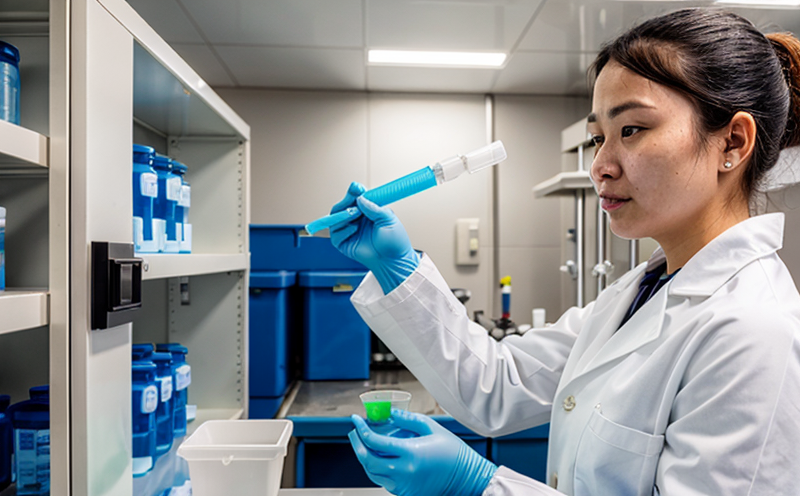USP Campylobacter Detection Testing
The USP Campylobacter Detection Test is a critical procedure used in pharmaceutical testing to ensure that medicinal products do not contain Campylobacter jejuni or other related species. This test is particularly important because these bacteria are known for causing foodborne illness, primarily through contaminated poultry and water supplies. The presence of Campylobacter spp. can compromise the quality and safety of pharmaceutical products intended for human consumption.
The United States Pharmacopeia (USP) has established specific guidelines for detecting Campylobacter in drug substances, excipients, and finished dosage forms as part of its monographs related to sterility testing. This test ensures that the product is free from harmful microorganisms, which is essential for maintaining patient safety.
The testing process involves several stages: sample preparation, inoculation onto selective media, incubation at appropriate temperatures, and final identification using biochemical tests or PCR methods if necessary. The FDA and other regulatory bodies mandate compliance with these procedures to ensure the reliability of results.
Compliance with USP standards is crucial for pharmaceutical companies as it ensures that their products meet stringent quality requirements and are safe for consumers. This testing process helps manufacturers maintain a high standard of hygiene in production facilities, reducing the risk of contamination from Campylobacter spp.
- Selective Media: Samples undergo incubation on media such as Cary-Blair transport medium which is selective for Campylobacter.
- Biochemical Tests: Positive isolates are further identified using biochemical tests like the API 20E system or VITEK 2 system.
- PCR Testing: In some cases, PCR methods may be used to confirm the presence of Campylobacter.
The importance of this test cannot be overstated. It is a key component in ensuring that pharmaceutical products meet the highest standards of quality and safety. By adhering to USP guidelines, companies can demonstrate their commitment to producing safe and effective medications.
Compliance with such stringent testing protocols also enhances the reputation of the company within the industry and among regulatory bodies. It reinforces trust between manufacturers and regulators, ensuring that products are free from harmful contaminants like Campylobacter.
In conclusion, USP Campylobacter Detection Testing is a vital step in the pharmaceutical testing process. It ensures that medicinal products are safe for consumption by eliminating potential sources of contamination. This test plays a crucial role in maintaining high standards of quality and safety, thereby protecting public health.
Why It Matters
The importance of USP Campylobacter Detection Testing cannot be overstated, especially within the pharmaceutical industry. Ensuring that medicinal products are free from harmful microorganisms such as Campylobacter jejuni is critical for maintaining patient safety and compliance with international standards.
Risk Management: The presence of Campylobacter spp. can lead to severe foodborne illnesses if the product finds its way into the market. By detecting these bacteria early in the manufacturing process, pharmaceutical companies can mitigate risks associated with contaminated products. This proactive approach helps prevent recalls and potential legal issues.
Regulatory Compliance: Regulatory bodies such as the FDA require strict adherence to USP monographs for sterility testing. Failure to comply can result in product withdrawals or recalls, leading to significant financial losses for pharmaceutical companies. Ensuring compliance through rigorous testing demonstrates a commitment to maintaining high standards of quality and safety.
Patient Safety: The health implications of consuming contaminated products are serious. Campylobacter infections can cause gastrointestinal symptoms ranging from mild diarrhea to life-threatening conditions in vulnerable populations. By detecting these bacteria early, companies can prevent the spread of illness and protect public health.
Brand Reputation: Consumer trust is paramount in the pharmaceutical industry. Demonstrating a commitment to quality through rigorous testing enhances brand reputation and fosters customer confidence. This positive perception can translate into increased market share and long-term business success.
In summary, USP Campylobacter Detection Testing is not just a compliance requirement; it is an essential step in ensuring patient safety, maintaining regulatory compliance, preventing risks, and building trust with consumers. By incorporating this test into their quality assurance protocols, pharmaceutical companies can safeguard public health while protecting their reputation.
Quality and Reliability Assurance
The reliability of the USP Campylobacter Detection Testing process is paramount for ensuring consistent results across various batches of a product. This section outlines key aspects that contribute to the quality and reliability of this testing method:
- Sensitivity: The test should be sensitive enough to detect even trace amounts of Campylobacter. Advanced media and incubation techniques ensure high sensitivity.
- Specificity: The test must be specific, distinguishing between Campylobacter species and other microorganisms. This specificity is achieved through targeted biochemical tests and PCR methods.
- Reproducibility: Results should be reproducible across different laboratories to ensure consistency. Standard operating procedures (SOPs) are critical for achieving this consistency.
- Data Accuracy: Accurate data recording and analysis are essential for reliable results. Automated systems can enhance accuracy by minimizing human error.
The combination of these factors ensures that the testing process is robust, providing consistent and accurate results every time. This reliability is crucial for maintaining trust in the pharmaceutical industry and ensuring patient safety.
Environmental and Sustainability Contributions
In addition to its role in ensuring product quality, USP Campylobacter Detection Testing also contributes positively to environmental sustainability. By preventing contaminated products from reaching the market, this testing helps reduce the risk of environmental contamination that could arise if harmful microorganisms were inadvertently released into natural ecosystems.
The use of selective media and advanced detection methods minimizes waste generation during the testing process. Furthermore, by ensuring that only high-quality products are released to the market, companies can contribute to reducing unnecessary returns and rejections, which in turn helps conserve resources and energy throughout the supply chain.
Through rigorous quality control measures, pharmaceutical manufacturers play a vital role in promoting sustainable practices within their industry. By adhering to strict testing protocols like USP Campylobacter Detection Testing, companies not only enhance product safety but also contribute to a more sustainable future.





